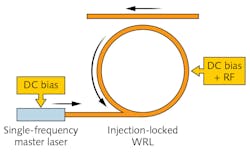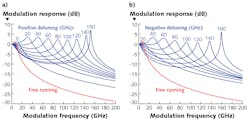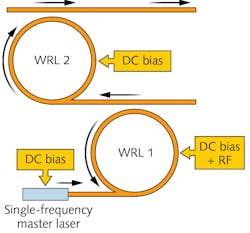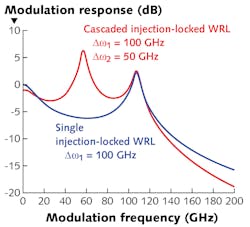Ultrafast Lasers: Injection-locked microring diode lasers enable ultrafast data transport
MAREK OSIŃSKI and GENNADY A. SMOLYAKOV
As the telecom and IT industries converge, the communications landscape is fast becoming user-driven, with the mass adoption of mobile broadband forcing network transformations. A massive growth in traffic volume as well as in the number of connected devices is expected. The fifth generation of mobile networks (5G) is the next major phase of mobile telecommunications beyond the currently implemented 4G networks, and is foreseen as the enabler for the Networked Society—a vision first introduced by Ericsson (Stockholm, Sweden) in 2011 wherein widespread Internet connectivity will transform everyday life for individuals and communities.1
In the Networked Society, everything that can benefit from a connection will be connected. New traffic types and data services will emerge, notably machine-to-machine communications to support concepts such as the smart grid, smart homes and cities, and e-health. Compared to 4G, the forecasts for 5G envision 1000X higher mobile data volume per area, 10-100X more connected devices, and 10-100X higher typical user data rate.2 As a result, 5G networks will have to handle extremely high aggregate data rates and much lower latencies than currently deployed 4G networks. To put this in perspective, current 4G networks transfer data at a speed of 10 gigabits per second (Gbit/s).
Current projections of optical data rates in 5G networks include 10, 40, 100, 200, and 400 Gbit/s as well as 1 Tbit/s,3 with a range of services such as multilayer software-defined networking, elastic optical network, hybrid optical switching, network function virtualization, optical cloud, and wireless backhaul. While standards have not yet been established, the planned 5G revolution is expected to push data transfer speeds to at least 40 Gbit/s.
To accomplish 5G optical transport, a new generation of optical components will be required, mainly based on integrated photonics, with low cost, small footprint, and reduced power consumption. These new optical advances will be essential to unlock the full potential of 5G, enabling a flexible, scalable, and cost-effective transport platform for the Networked Society.
The continuing increase of transmission rates and capacity at all levels of telecommunication and wireless networks raises demand for very high-speed, low-cost optical transmitters. Our team at the University of New Mexico is working towards experimental demonstration of a new concept of ultrafast transmitters for 4G and 5G wireless networks and data centers, based on strongly injection-locked semiconductor ring lasers.
Enhancement of modulation bandwidth
Since their inception, semiconductor lasers have been key components for many applications in optical fiber communications because of their excellent spectral and beam properties and their ability to be directly modulated at very high rates. However, their frequency response has limited the commercial use of directly modulated lasers to digital transmission not exceeding 10 Gbit/s.
The modulation response of a diode laser is determined by the rate at which the electrons and holes recombine in the active region (spontaneous carrier lifetime tsp), and the rate at which photons can escape from the laser cavity (photon lifetime tp). The modulation bandwidth is limited by the relaxation oscillation frequency fRO given by the classical formula of Lau and Yariv:
where vg is the group velocity, gN is the differential optical gain, and Np is the average photon density in the laser cavity.4
This relation suggests that the relaxation oscillation frequency can be increased by proper design of laser parameters to get either higher photon density or shorter photon lifetime. Increased injection currents for higher Np values and shorter laser cavities for smaller tp are ordinarily used for that purpose in diode lasers. Both approaches, however, involve higher injection current densities that could result in optical damage to the laser facets and excessive heating. Therefore, safe levels of injection current limit in practice the modulation bandwidth of free-running semiconductor lasers.
Optical injection locking has been shown to be an extremely effective method to improve microwave performance and linearity of diode lasers, and to reach beyond the record values of modulation bandwidth achieved for free-running devices.5 The technique uses the continuous-wave (CW) output of a single-frequency laser (master) to optically lock another laser (slave) that can still be directly modulated. Significant increase in the resonance frequency and modulation bandwidth, with reduction in nonlinear distortions and frequency chirp, has been achieved by injecting external light into diode lasers.
So far, improved microwave performance has been observed in Fabry-Perot edge-emitting lasers, distributed feedback (DFB) lasers, and vertical-cavity surface-emitting lasers (VCSELs). The highest experimentally observed 3 dB bandwidth of approximately 80 GHz--by far exceeding that achieved for free-running devices-has been reported in injection-locked VCSELs.5
While laboratory experiments have demonstrated record-high values for enhanced modulation bandwidth, injection-locked VCSELs require multiple hybrid components that need to be carefully aligned. Their vertical geometry makes VCSELs unsuitable for monolithic integration with the distributed Bragg reflector (DBR) or DFB lasers used as masters.
Strong optical injection is crucial for reaching the ultimate limits of modulation bandwidth enhancement in injection-locked lasers. The smallest possible values for both the cavity roundtrip time trt and the reflectivity R of the mirror used for injection (maximizing the injection coupling rate coefficient kc) would be ideal for that application. The inherent design tradeoff between these parameters, however, makes further optimization of both edge-emitting lasers and VCSELs for enhanced high-speed performance very problematic, as dictated by the requirement to keep threshold current at an acceptable level.
In edge-emitting lasers, the advantage of a rather low mirror reflectivity R is compromised by a large value of trtbecause of relatively long laser cavities. Conversely, in injection-locked VCSELs, the benefit of short cavities leading to smaller trt is compromised by very high mirror reflectivities, resulting in coupling rate coefficients similar to edge emitters. Hence, further improvement of modulation bandwidth in injection-locked VCSELs is expected to come solely from higher-power master lasers used for optical injection.
Strongly injection-locked whistle-geometry ring lasers
To overcome the limitations of current transmitters, we have proposed a novel injection-locking scheme involving a DBR master laser monolithically integrated with a whistle-geometry ring laser (WRL; see Fig. 1). Inherently unidirectional WRLs are ideal for this application, as they can be designed for minimal back-reflections. The novel scheme allows for strong coupling of the master laser output into the ring laser, providing dramatically increased injection coupling rate.
By the very nature of WRL, low reflectivity for incident light would not at all compromise the quality of the ring cavity, and would not affect the threshold condition for the wave propagating in the favored direction. This makes WRLs free from the design constraints that other semiconductor lasers suffer from.
It should be emphasized that injection locking systems are generally very large and bulky, which makes them unsuitable for practical applications. The monolithically integrated system described previously will be the first of its kind—exploiting the unique geometry of WRLs that allows for a complete coupling of the master laser light into the slave, eliminating the need for an optical isolator to protect the master laser from optical feedback, and enabling development of a compact ultrafast transmitter suitable for commercial optical data transport applications.
Our numerical simulations predict a greatly enhanced resonance frequency of up to approximately 160 GHz for the strongly injection-locked ring laser.6 Typical for all optical injection-locking schemes, however, the modulation response shows a very significant reduction in the modulation efficiency between low frequencies and the resonance frequency, which limits the usefulness of the novel scheme to narrowband applications (see Fig. 2).Ultrahigh-speed (>100 GHz) on-chip modulation of integrated lasers is an important "holy grail" for the ever-increasing demand for ultrafast communication. The successful demonstration of the optoelectronic integrated circuits we are developing has the potential for huge societal impact by increasing the transmission capacity of fiber-based networks to at least 100 Gbit/s per channel without any multiplexing, pushing us closer towards a truly Networked Society.
Acknowledgements
Our experimental work was seeded by the Technology Research Collaborative funded by the State of New Mexico in 2016, and is now supported by the Office of Naval Research. Early theoretical work on strong injection locking of ring lasers was supported by the National Science Foundation.
References
1. B. Skubic et al., J. Lightw. Technol., 33, 5, 1084-1091 (2015).
2. A. Pizzinat et al., J. Lightw. Technol., 33, 5, 1077-1083 (2015).
3. S. Aleksić, "Towards fifth-generation (5G) optical transport networks", Proc. 17th International Conf. on Transparent Optical Networks(ICTON 2015), paper We.A2.2, Budapest, Hungary (July 5-9, 2015).
4. K. Y. Lau and A. Yariv, IEEE J. Quantum Electron., 21, 2, 121-138 (1985).
5. E. K. Lau et al., IEEE J. Sel. Topics Quantum Electron., 15, 3, 618-633 (2009).
6. G. A. Smolyakov and M. Osiński, J. Quantum Electron., 47, 11, 1463-1471 (2011).
7. X. Zhao et al., Opt. Express, 15, 22, 14810-14816 (2007).
8. G. A. Smolyakov et al., IEEE J. Quantum Electron., 48, 12, 1568-1577 (2012).
Marek Osiński is a Gardner-Zemke Professor of Electrical and Computer Engineering, Physics and Astronomy, and Computer Science, and Gennady A. Smolyakov is a Research Associate Professor of Electrical and Computer Engineering, both at the Center for High Technology Materials at the University of New Mexico, Albuquerque, NM; e-mail: [email protected]u; www.chtm.unm.edu.




